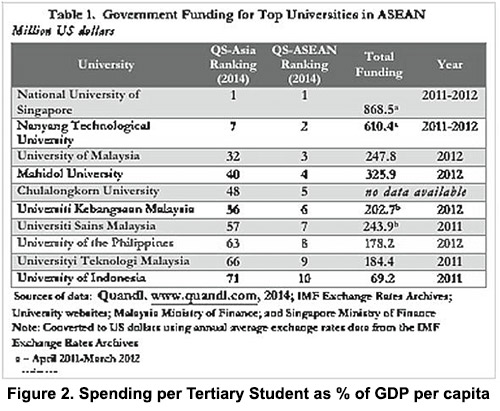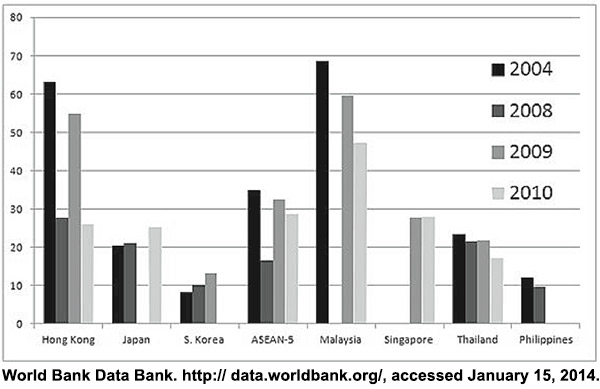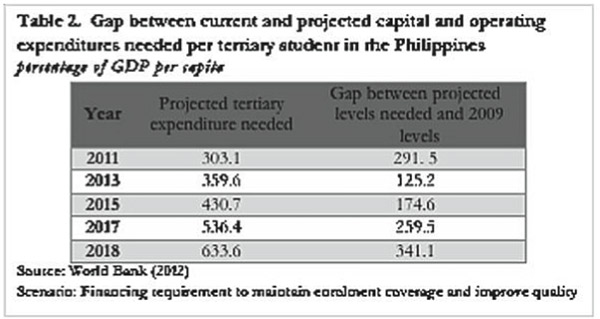Scaling up the UP budget to face up to AEC competition
The role of higher education in economic development
Research in development and education economics reveals that technological innovation and economic growth are interactive and mutually reinforcing. That is to say, economic growth can be effectively sustained by spending for technological innovation that results in new processes, products and markets, and technological innovation in turn can come about from research and development (R&D) made possible by economic growth.
Substantial investments in higher education including science, technology and research are in fact what underlie the sustained rapid growth and poverty reduction achieved by the East Asian miracle economies (Taiwan, South Korea, and Hong Kong). A pattern followed by the Philippines’ ASEAN neighbors — Singapore, Malaysia, Thailand, and Indonesia (Figure 1).
Education in general in the Philippines (PH) has been at a virtual standstill, if not regressing, except in recent years under the administration of President Benigno S. Aquino III when education was given a higher priority. Nevertheless, the lag in higher education stands out when PH is compared with its ASEAN-4 neighbors, not to mention global standards. A main reason for PH’s laggard position is the shortfall in government funding, as Table 1 and Figure 2 indicate.


A World Bank (2012) study on the link of higher education and skills to economic growth in East Asia highlights the need to “finance adequately the aspects of higher education that correct for externalities and market failures, such as research, science, technology, engineering, math, and scholarships and loans for the poor and disadvantaged.†The need for greater efficiency of public financing of education entails a “more selective and performance-based approach in the way public funds for teaching and research are allocated across institutions and targeting scholarships and loans better.†Apart from the government, private resources could be harnessed to augment public funds. Public-private matching grant schemes have been applied in other countries with good results.
The study also underscores the case for public financing to support research and STEM (science, technology, engineering and mathematics) capacity as two areas with high positive externalities. Although the financial costs can be high, the social benefits are greater, considering the positive link to innovation. There is a need to develop and allocate resources to a few premier research and teaching universities, such as UP. Such selectivity — directing substantial resources to a small number of institutions — takes into account the substantial resource requirements to undertake high-level research and teaching. To the extent that the few select institutions meet international standards in teaching or research, the trend in low-cost and low-quality education can be reversed.
Moreover, the same study simulates the financing needs for the Philippines and projects large capital and increasing recurrent expenditures such as salaries, administrative costs, and costs for faculty qualification upgrading to improve the quality of education while maintaining enrollment rates. The results reveal that expenditure (for capital, operating and other recurrent expenditures, etc.) needs to grow from nearly $6,000 per student per year to about $10,000 (Table 2).

Further, linking the higher education system to the private sector is an important aspect of education policy such that the curriculum becomes more responsive to the needs of the industry, thereby avoiding skill gaps and disconnects. For the country, it is extremely critical to have both a solid skill base and a stronger capacity for innovation through research and skillful application. In sum, the country must focus on improving the quality of graduates and inclusiveness while building research capacity in a few universities, such as UP.
Regional and global competition
Higher education institutions (HEIs) are regularly ranked regionally and internationally. In the 2014 Quacquarelli-Symonds (QS) rankings of Asian universities, of the 38 ASEAN universities in the top 250, the Philippines has only four, viz. UP, ADMU, UST, and DLSU. The main criteria in the rankings are academic reputation, employer reputation, faculty-student ratio, papers per faculty, citations per paper, international faculty and students, and inbound and outbound exchanges.
When the ASEAN Economic Community (AEC) integration comes into full effect by the end of 2015, the unrestricted flow of faculty and students (apart from goods, capital and labor) across national borders can be expected. It is urgent, therefore, that Philippine HEIs take qualitative improvements in their faculties and curricula much more seriously.
Of the four top universities in the Philippines, only UP — the “national university†— is publicly funded. Owing to the rush of retirements of senior faculty members (belonging to the “baby boomâ€), besides the rising number of younger faculty members being drawn to higher salaries in other universities here and abroad, as well as in the private sector, UP’s faculty strength has been eroding. A comparison of UP faculty compensation vis-à -vis its competitor universities in ASEAN is shown in Table 3.

The tertiary student-teacher ratio for the Philippines is 23.2, which is higher than most of its ASEAN counterparts, such as Thailand (13.7), Malaysia (14.2), and Singapore (19.9) (see Table 4). Given that the student-teacher ratio is indicative of the time spent in classroom instruction and individual consultations, it implies the tradeoff in hours spent between instruction and research. A Malaysian study shows that Malaysian universities (both public and private) spend an average of 18 hours per week on teaching and related responsibilities, nine hours on research and five hours on other services during the semester (Altbach, et al. 2012). Research time goes up to 14 hours while teaching drops to 10 hours per week when universities are not in session.
The UP leadership feels strongly that there is an urgent need and compelling rationale for scaling up the UP budget, including faculty and staff salaries, toward enhancing the university’s competitive standing, regionally and globally. More importantly, the national university needs to more significantly contribute to the country’s capacity to technologically progress and innovate, thereby becoming a knowledge economy in due time. Studies point out that a skilled workforce must be complemented by highly skilled professionals/technicians who take the lead in innovation and technological developments for the implementation of technical advances in the economy. This is where the national university must take the lead in making a real contribution to the nation.

The UP president makes a strong plea for a substantial increase in the budget of the national university to, among others, be able to significantly raise faculty and staff salaries to make them more competitive vis-Ã -vis HEIs in the AEC, besides local competitor universities and firms in private sector. UP fears that with AEC integration coming into full force, the national university will not be able to attract or retain neither Filipino faculty (with the required academic degrees) nor international faculty and students. Worse, UP might find itself more rapidly losing faculty and students to its AEC competitors.
* * *
References
ADB Statistical Database System. http://www.adb.org/data/sdbs, accessed January 15, 2014.
Aldaba, Rafaelita, et al. 2011. “Result of the 2009 Survey of Innovation Activities,†Discussion Paper 2011-15. Makati City: Philippine Institute of Development Studies.
Altbach, Phillip et al. 2012. Paying the Professoriate: A Global Comparison of Compensation and Contracts. London: Routledge.
Asian Development Bank. 2007. Philippines: Critical Development Constraints. Manila: Asian Development Bank.
Bautista, Carlos. 2002. “Boom-bust cycles and crisis periods in the Philippines: a regime switching analysis,†The Philippine Review of Economics XXXIX (1): p. 20-37.
Bosworth, B., and S. Collins. 2003. “The Empirics of Growth: An Update,†Brookings Papers on Economic Activity 2: 113–207.
Ciccone, Antonio, and Elias Papaioannou. 2009. “Human capital, the structure of production, and growth,†The Review of Economics and Statistics 91.1: 66-82.
Cohen, Daniel, and Marcelo Soto. 2007. “Growth and human capital: good data, good results,†Journal of Economic Growth 12.1: 51-76.
Falk, Emma. 2010. “2009-2010 Academic Staff Salary Survey,†The Association Commonwealth Universities.
Hanushek, Eric A., and Ludger Woessmann. 2012. “Do better schools lead to more growth? Cognitive skills, economic outcomes, and causation,†Journal of Economic Growth 17.4: 267-321.
Hanushek, Eric A., and Ludger Woessmann. 2008. “The role of cognitive skills in economic development,†Journal of Economic Literature, pp. 607-668.
International Monetary Fund Exchange Rates Archives. https://www.imf.org/external/np/fin/data/param_rms_mth.aspx, accessed February 2014.
International Monetary Fund World Economic Outlook Database. http://www.imf.org/external/pubs/ft/weo/2013/02/weodata/index.aspx, accessed January 15, 2014.
National Economic and Development Authority. 2011. Philippine Development Plan 2011-2016. Pasig: NEDA.
Office of the President [2012] Executive Order No. 76. Implementation of the Fourth Tranche of the Modified Salary Schedule for Civilian Personnel and Base Pay Schedule for Military and Uniformed Personnel in the Government. Manila: Malacañang.
Quandl. www.quandl.com, accessed February 17, 2014.
UNESCO Institute of Statistics. http://www.uis.unesco.org/Education/Pages/default.aspx?SPSLanguage=EN, accessed February 2014.
United Nations Industrial Development Organization Online Database. http://www.unido.org/data1/Statistics/Research/cip.html, accessed January 15, 2014.
World Bank. 2010. “Philippines Skills Report: Skills for the Labor Market in the Philippines,†Manila: World Bank Country Office.
The World Bank. 2012. “Putting Higher Education to Work: Skills and Research for Growth in East Asia,†East Asia and Pacific Regional Report. Washington, DC: World Bank
World Bank Data. http://data.worldbank.org/, accessed January 15, 2014.
World Economic Forum. 2013. Global Competitiveness Report 2013-2014. Geneva: WEF.
* * *
Dr. E.M. Pernia is professor emeritus of the School of Economics, UP Diliman. Dr. R.L. Clarete is dean of the School of Economics, UP Diliman. Dr. G.P. Padilla–Concepcion is vice president for academic affairs of the UP System and professor of the Marine Science Institute, UP Diliman. The authors are members of a committee created by UP president Alfredo E. Pascual to provide the background and rationale for greater investment in higher education and R&D in UP. Ammielou Gaduena and Adrian Mendoza, Ph.D. candidates at the UP School of Economics, extended very able research assistance. E-mail at [email protected].
- Latest

























